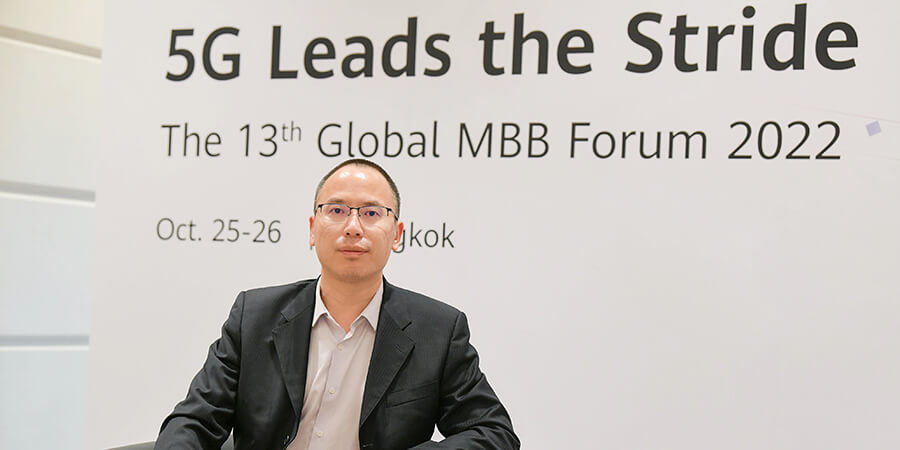GSMA reported that 5G users will reach one billion by the end of 2022, amid more and more 5G terminals, as well as the increasing deployment of base stations across the globe. And these relentless developments enable 5G to realize its promises and unleash its full potential.
With its larger bandwidth, very minimal latency, improved security, and the powerful connection it could bring to users across the globe, 5G will highly likely lead a lot of unprecedented and revolutionary technological applications.
And as Huawei continues to lead the future of 5G, it is also pushing 5G to the next level by collaborating with carriers and industry partners.
In an interview with Telecom Review, Cao Ming, Vice President of Huawei Wireless Network Product Line, explained how Huawei defines “stride” from the perspective of global 5G development.
Data from GSMA shows that there are now 225 sets of commercial 5G networks deployed in 89 countries, while total 5G subscribers reached 1 billion.
“We are working with our industry partners and other relevant parties to create a favorable environment for the evolution of 5G and 5.5G. We are trying to make it even easier for the access of all the relevant resources and facilities for the development of 5G and 5.5G. We are also working with industry partners to facilitate the development of 5G terminals and applications,” said Mr. Cao Ming.
To enable more people to enjoy the benefits of 5G, Huawei, together with its industry partners, has continued to find solutions to support this technology such as introducing low-cost smart devices, entry-level mobile devices for 5G. Huawei has managed to make these entry-level 5G-enabled devices available for just as low as $100.
Huawei has also been working with OTT vendors to innovate 5G services available to end users. In China, for example, video definition has been significantly improved, from 480P or 360P to HD and even UHD 720P as well as 1,080P.
Moreover, Huawei has helped make great strides in streamlining the operations and maintenance in various manufacturing industries. An example of this is smart mining, which remotely-located operators are now able to control four driverless trucks to ferry the ore from the excavator to the processing facility for crushing and processing. As a result, there has been minimal risks of deaths or injuries among coal miners.
Huawei’s 5G innovation has also contributed to the development or digital transformation of countries and regions. Mr. Cao Ming said, “We are innovating to achieve solutions with ultra-wideband multiple antenna technology and to deliver green and power saving-equipment to bring better experience to the end users and reduce cost for carriers.”
Among the most notable solutions that Huawei has revolutionized is the ultra-high-power ultra-wideband 8T8R RRU, which work with the Hertz platform 8T8R antenna. This has widely enhanced coverage and capacity.
To reduce the cost for carriers and allow more sustainable solutions, Huawei has also simplified the deployment of multiple frequency bands by combining all in one single module. The dual-band 8T8R RRU uses the integrated wideband power amplifier that supports both FDD 1.8 GHz and 2.1 GHz.
Mr. Cao Ming continues, “That means with the number of sites and spectrum resources unchanged, carriers now are capable of delivering even larger capacity and better user experience.”
Huawei’s innovative solutions to unlock the limitation of sites and spectrum resources
Amid the higher demand for data services, Huawei is also seeing hurdles along the road to 5G.
The scarcity of sites and spectrum resources is an urgent issue to be resolved. Mr. Cao Ming said, “We do see several major challenges for carriers and diff industries in the 5G era. First, the sites and spectrum resources are limited for all carriers. And besides, with the introduction of 5G, now the existing network we can see four different generations of wireless technology coexisting that is 2G, 3G, 4G and 5G.”
Such kind of coexisting of multiple RAT (Radio Access Technology) is expected to lead to extreme complexity of network deployment, as well as operation and maintenance and might incur high costs.
Furthermore, Huawei sees that all around the world, DoU (Users’ Data Traffic Per User Per Month) has been climbing up very fast. That means user services are growing very fast as well, which may strain the current network capacity.
“Now you will see the dilemma here. On the one hand, the spectrum and resources are quite limited. On the other hand, there are increasing user devices and the services are more and more demanding on the network capacity,” Mr. Cao Ming explained.
And these multiple frequency bands and RAT within the network may not help countries globally that are setting their own green power-saving targets.
Mr. Cao Ming continued, “If we’re to approach such challenges from the technology point of view, with limited sites and spectrum resources, the only way left us is to innovate towards ultra-wideband, multi-antenna and intelligent technologies. And Huawei’s innovative MIMO technology is one of the answers to that.”
Compared to the traditional solutions with same frequency band, Huawei’s massive MIMO can increase capacity by 10 times.
With Huawei’s ultra-wideband solution, it can now incorporate the low-frequency bands into a single box, which means 700MHz, 800MHz and 900MHz can all be combined in one box. And Huawei can provide another box for the medium-frequency bands, such as 1.8+2.1+1.4/2.6 GHz.
Mr. Cao Ming said, “We take that into consideration so now with our ultra-wideband solution, in one sector, we can support all these frequency bands with all these boxes.”
He added that this solution can significant simplify the deployment onsite, reduce the carrier’s cost and be more power-efficient. “For the evolution of technologies in the future, we will continue with our current approach that is to pursue ultra-wideband multi antenna, intelligent, green and power-saving technologies to deliver user cross generation experience, reduce carriers’ cost and contribute to achieving green and carbon emission goals,” Mr. Cao Ming said.











